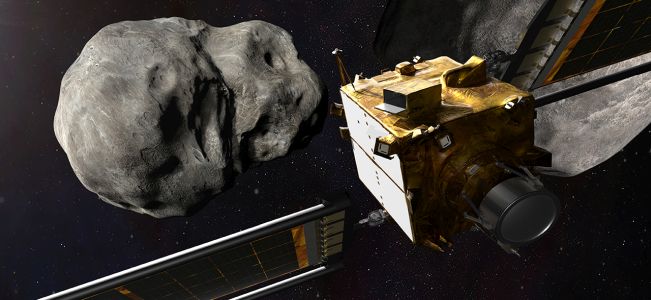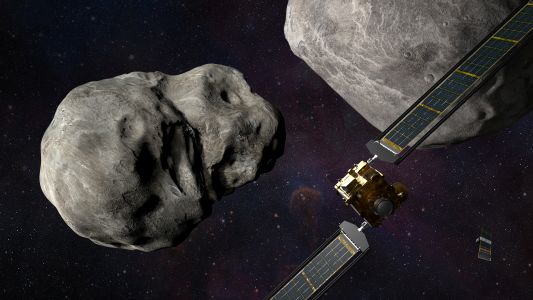
Armageddon test: NASA launching spacecraft in first-ever planetary defense asteroid deflecting test

It’s comforting to know that very few of the billions of asteroids and comets orbiting our Sun are potentially hazardous to Earth. And, for at least the next hundred years or so, no known asteroid threatens our planet. NASA’s DART mission is a key test that the American Space Agency and other U.S. and international space agencies will perform before any actual need is present, in an effort to better prepare our defenses should we ever discover an asteroid on a collision course with Earth.
The DART spacecraft, which was built and is operated by the Johns Hopkins Applied Physics Laboratory (APL) in Laurel, Maryland, at the direction of NASA’s Planetary Defense Coordination Office (PDCO), is designed to demonstrate that an asteroid that could cause regional devastation — one just a few hundred feet across — can be deflected by intentionally crashing a spacecraft into it. This method, called kinetic impact deflection, is just one of several proposed ways to redirect potentially hazardous asteroids, but it’s the one currently assessed as the most technologically mature.
The DART mission is a test run for when Earth is faced with an incoming asteroid that’s threatening our planet. DART will arrive at its target asteroid in late 2022 with an impact, becoming the first Earth mission in our history to deflect an asteroid.
DART will launch aboard a SpaceX Falcon 9 rocket from Vandenberg Air Force Base in California. After separation from the launch vehicle and over a year of cruise it will intercept Didymos’ moonlet in late September 2022, when the Didymos system is within about 7 million miles (11 million km) of Earth. The relatively close distance between Earth and the asteroid at that time will let scientists observe the asteroid at the time of impact with ground-based telescopes and planetary radar. ~ EarthSky
Scientists say that there is no danger to the planet Earth resulting from this test.
After impact, the investigation team will measure how much the asteroid is deflected using telescopes on Earth. This mission also engages the international planetary science community in many ways, embracing worldwide cooperation to address the global issue of planetary defense.
NASA will provide coverage of the upcoming prelaunch and launch activities for the agency’s first planetary defense test mission, the Double Asteroid Redirection Test (DART). The mission will help determine if intentionally crashing a spacecraft into an asteroid is an effective way to change its course. DART’s target asteroid is not a threat to Earth.
DART is scheduled to launch no earlier than 1:20 a.m. EST Wednesday, November 24 (10:20 p.m. PST Tuesday, November 23) on a SpaceX Falcon 9 rocket from Vandenberg Space Force Base in California.
Live launch coverage on NASA Television will begin at 12:30 a.m. EST Wednesday, November 24, on NASA Television, the NASA app, and the agency’s website, with prelaunch and science briefings beginning Sunday, November 21.
The launch, briefings, and news conferences will stream live on NASA’s Facebook, Twitter and YouTube channels. Members of the public can participate live by submitting questions in the comment section of the streams, or by using #AskNASA.
The spacecraft is designed to direct itself to impact an asteroid while traveling at a speed of roughly 15,000 miles per hour. Its target is the asteroid moonlet Dimorphos (Greek for “two forms”), which orbits a larger asteroid named Didymos (Greek for “twin”). In fall 2022, DART will impact Dimorphos to change its orbit within the Didymos binary asteroid system. The Didymos system is the ideal candidate for DART because it poses no actual impact threat to Earth, and scientists can measure the change in Dimorphos’ orbit with ground-based telescopes. ~ NASA
Planetary Defender Campaign
To allow the public to share in the excitement of DART, NASA has launched the Planetary Defenders campaign. Participants can answer a short series of questions about planetary defense to earn their planetary defender certificate, which they can download or print, as well as a digital badge to share on social media using the hashtag #PlanetaryDefender.
Public Participation
Members of the public can register to attend the launch virtually. NASA’s virtual guest program for DART includes curated launch resources, a behind-the-scenes look at the mission, and the opportunity for a virtual guest launch passport stamp.
For more information about DART, check out the video accompanying this article and visit: https://www.nasa.gov/dartmission
(Sources: NASA / APL)
Posted by Richard Webster, Ace News Today / Follow Richard on Facebook and Twitter









